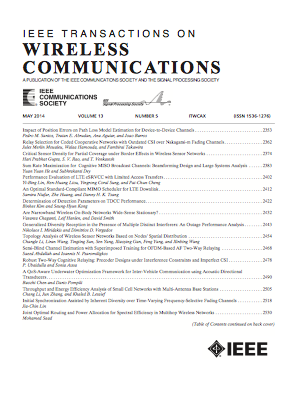Dynamic Aerial Reconfigurable Intelligent Surface Aided Multi-Cell Multi-User Communications
IF 10.7
1区 计算机科学
Q1 ENGINEERING, ELECTRICAL & ELECTRONIC
引用次数: 0
Abstract
In aerial reconfigurable intelligent surface (RIS) aided networks, high line-of-sight (LoS) and agility characteristics provide favorable conditions for RIS reflection. However, this also introduces extra LoS RIS reflection interference, especially when aerial RIS is fixedly deployed. This paper proposes a dynamic unmanned aerial vehicle (UAV)-mounted RIS aided multi-cell multi-user communication scheme, where the minimum ergodic rate of randomly mobile users is maximized through joint optimization of BS beamforming, RIS phases, user scheduling and UAV trajectory under the assumption of only statistical channel state information. Specifically, a closed-form ergodic rate approximation is derived, based on which the block coordinate descent framework is leveraged to solve the above four variables due to the non-convexity of the problem. Furthermore, the optimal beamforming is acquired in closed form utilizing fractional programming and quadratic transformation, RIS phases are optimized by the complex circle manifold, user scheduling is obtained by the reconstruction-based relaxation, and UAV trajectory is solved through the first-order Taylor expansion and successive convex optimization techniques. Moreover, the complexity of the proposed algorithm is analyzed and its convergence is carefully proved. The numerical results demonstrate our proposed scheme achieves a better ergodic rate than traditional methods and other aerial schemes with heuristic trajectories.动态空中可重构智能表面辅助多小区多用户通信
在空中可重构智能表面(RIS)辅助网络中,高视距(LoS)和敏捷特性为 RIS 反射提供了有利条件。然而,这也带来了额外的 LoS RIS 反射干扰,尤其是当空中 RIS 固定部署时。本文提出了一种动态无人飞行器(UAV)安装 RIS 辅助多小区多用户通信方案,在仅统计信道状态信息的假设下,通过联合优化 BS 波束成形、RIS 阶段、用户调度和 UAV 轨迹,最大化随机移动用户的最小遍历率。具体来说,由于问题的非凸性,在此基础上利用块坐标下降框架来解决上述四个变量的问题,从而推导出了一个闭式遍历率近似值。此外,利用分数编程和二次变换以闭合形式获得最佳波束成形,利用复圆流形优化 RIS 相位,利用基于重构的松弛法获得用户调度,并通过一阶泰勒展开和连续凸优化技术解决无人机轨迹问题。此外,还分析了所提算法的复杂性,并仔细证明了其收敛性。数值结果表明,与传统方法和其他采用启发式轨迹的空中方案相比,我们提出的方案实现了更好的遍历率。
本文章由计算机程序翻译,如有差异,请以英文原文为准。
求助全文
约1分钟内获得全文
求助全文
来源期刊
CiteScore
18.60
自引率
10.60%
发文量
708
审稿时长
5.6 months
期刊介绍:
The IEEE Transactions on Wireless Communications is a prestigious publication that showcases cutting-edge advancements in wireless communications. It welcomes both theoretical and practical contributions in various areas. The scope of the Transactions encompasses a wide range of topics, including modulation and coding, detection and estimation, propagation and channel characterization, and diversity techniques. The journal also emphasizes the physical and link layer communication aspects of network architectures and protocols.
The journal is open to papers on specific topics or non-traditional topics related to specific application areas. This includes simulation tools and methodologies, orthogonal frequency division multiplexing, MIMO systems, and wireless over optical technologies.
Overall, the IEEE Transactions on Wireless Communications serves as a platform for high-quality manuscripts that push the boundaries of wireless communications and contribute to advancements in the field.

 求助内容:
求助内容: 应助结果提醒方式:
应助结果提醒方式:


